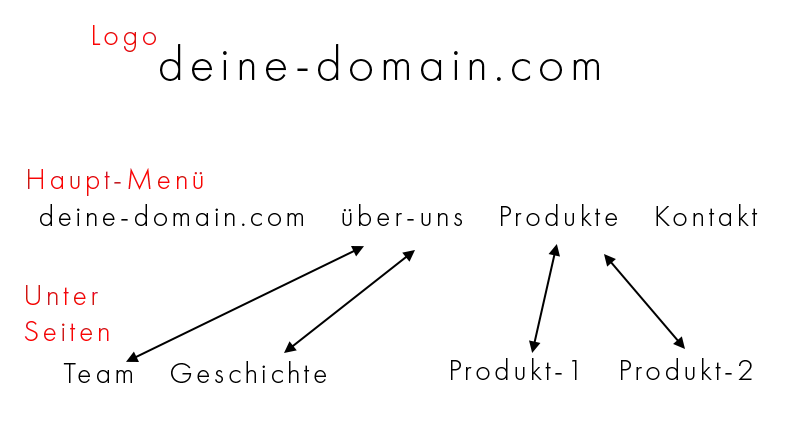In digital marketing, internal links have an important SEO function. Internal linking shows the importance of individual pages on a website. Visually, this structure can be imagined as a pyramid: At the top is the general address of the website your-domain.com. At the very bottom are the most distant subpages of the website. In a standard configuration, each subpage is linked not only to the direct parent page, but also to all parent pages. This means that the top page (your-domain.com) receives the most links and is classified by Google as the most important page in the structure (see figure below).
The standard layout of a website for mobile navigation (Google indexes mobile) shows the company logo at the top left and a hamburger menu at the top right. The logo is usually linked to the main page (your-domain.com). In the menu, the link to the main page is usually repeated under the name "Home" and highlights the most important categories of the page, e.g. "About us", "Contact" and "Products". Each category can have several subcategories, but these do not necessarily have to appear in the menu. The main page your-domain.com therefore receives twice as many links as the other main menu items, since there is one link in the menu + one link by the logo. The link pyramid therefore looks like this:

Each of the lower pages links to the pages directly above it, but also to all the pages above it. The "Team" page is attached to "about us", but due to the menu structure it has links to about us, products, contact and (twice - main menu & logo) to your-domain.com. In this example, the "Team" subpage in the structure only gets one link (from "about us"), while the "about us" page gets nine links, one from each existing page, i.e. your-domain.com, products, contact, team, story, product-1, product-2, plus a duplicate link each from "team" and "story". The "Contact" page only gets seven links because it has no subpages and thus the duplicate links are eliminated. So in the internal link structure, "About us" is more important than "Contact". The your-domain.com page gets 14 links because it gets a link from both the menu and the logo on every page (i.e. twice).
This link structure is important in digital marketing for SEO, as search engines like Google and Bing classify pages with more internal links as "more important" than pages with fewer internal links. For example, the "about us" page (nine internal links) is more important than the "contact" page (seven internal links). If you want to make the "contact" page one of the most important pages on the website, you can add an additional link to "contact" on every menu and subpage.
At this point, it is important to note that the internal linking structure was more relevant to Google in the past than it is today. From my own experience in SEO optimization of numerous websites, I have come to the conclusion that other factors such as dwell time are more relevant than internal linking. A page that is well received by users, where users find exactly what they googled for, will be highlighted by Google in comparison to imprecise pages, without internal linking having a major impact.
Author: Felix C. Richter, August 24, 2024.
